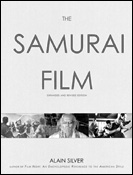The Samurai Film
by Tom Mes
Despite being the oldest, most recognisable and arguably the most popular genre in Japanese film, the samurai film has had surprisingly little written about it in book form outside its home territory. Most of what exists in English forms part of studies on Akira Kurosawa, and for a very long time the only real publication devoted to the genre remained Alain Silver's The Samurai Film, which first appeared back in 1977. The situation is about to change though, and not a moment too soon, what with the renewed interest in the genre through the efforts of Quentin Tarantino and Tom Cruise. The second half of 2005 not only sees the return of Silver's tome in an updated and expanded third edition, but also the publication of a brand new volume, Patrick Galloway's Stray Dogs & Lone Wolves: The Samurai Film Handbook.
You could easily construe the lack of coverage of this monumental genre as a testament to the thorough work Silver put into his tome. The Samurai Film has always been one of the standard publications on Japanese cinema in English, covering the genre with great erudition and perceptiveness. With so many of the standard works on Japanese film disappearing from the shelves due to a publishing industry increasingly obsessed with bestseller rankings and Oprah's reading list, Overlook Press deserves a big round of applause for resurrecting Silver's study for a new generation (although it's doubtful they would have taken the risk if Kill Bill and The Last Samurai had flopped). The author obliges by adding an entirely new chapter in which these two American hommages films feature prominently, but, characteristic of the book's approach as a whole, he places these foreign tributes into the proper context of the chanbara genre's evolution over the past twenty-odd years.
The Samurai Film is still every bit as thorough as it ever was. Silver takes the time to define everything from narrative and character types, via the use and function of violence, to the roots of the celluloid samurai in fact, art and fiction - all before the first film is even mentioned. Key directors (Kurosawa, Gosha, Okamoto, Shinoda), series (including perennial fan favourites Zatoichi - expanded to include the Kitano version - and The Sleepy Eyes of Death), characters (like Musashi Miyamoto) and individual films are scrutinised and discussed in great depth. The chapter on Hideo Gosha (he and Kurosawa are the only directors to have an entire chapter dedicated to them) still stands as the single most important and authoritative piece of writing on this great director (but what a shame that almost no one has followed suit and actually released a few of his films...).
The author's approach regularly results in close textual analysis, but he always works from the larger framework of demonstrating, by way of his various test cases, how the genre functions and to what ends. The results never cross the line into becoming ham-fisted or bogged down in jargon. A great example are the few paragraphs devoted to Throne of Blood, in which Silver very succinctly tells us exactly why Kurosawa is a great filmmaker - without ever resorting to hackneyed talk about humanism and rousing epics.
Silver's point of departure for his analyses is always the film itself. He never attempts to hammer his subjects into any kind of theoretical mould, which is exactly why The Samurai Film is still every bit as pertinent as it was thirty years ago. Had the author placed his labours within any of the critical frameworks popular at the time of its original publication, the text would by now have felt badly dated and the book would have become a relic. Instead, it achieves what all great film analysis does: it helps you understand the genre and the films better, and thereby enjoy them all the more as a result. With the updated text it's destined to hold up for probably quite a few decades to come. Like many of the movies it discusses, The Samurai Film is a bona fide classic. Mandatory reading for anyone interested in Japanese film.
